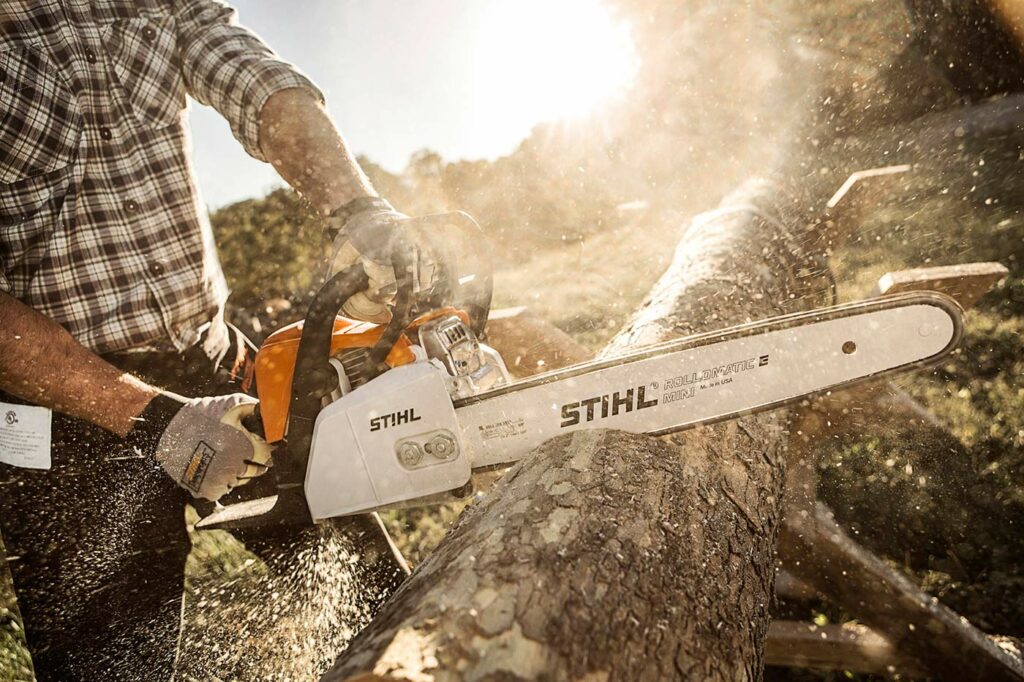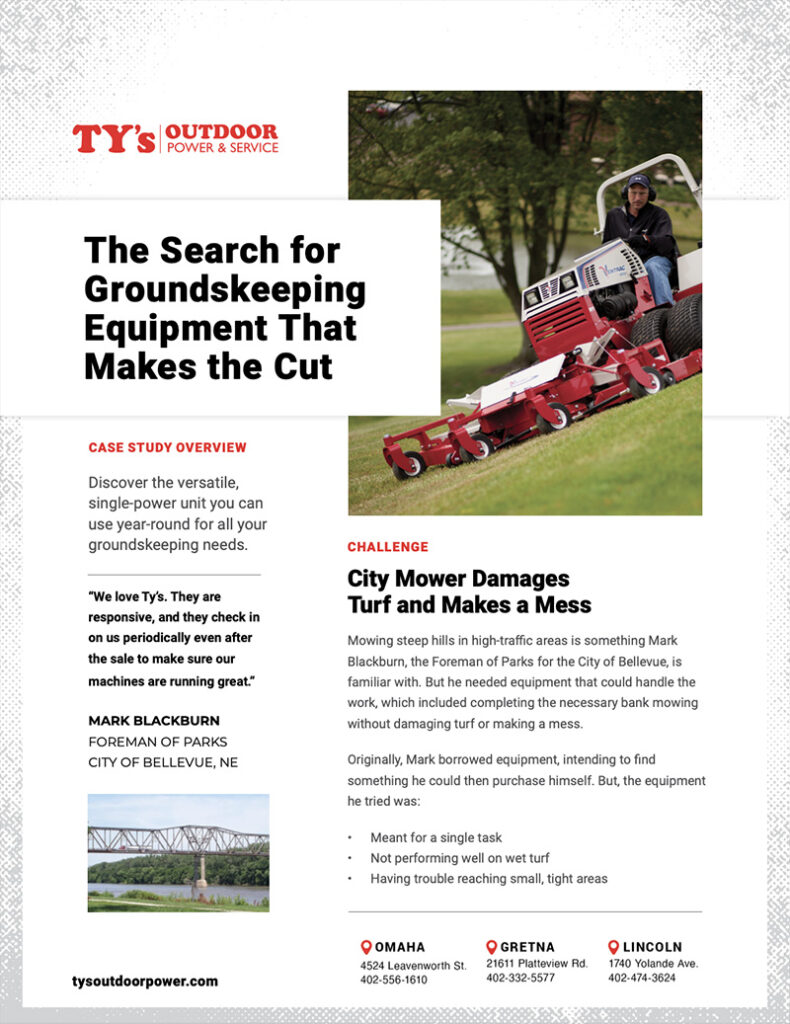Scary movies and funny commercials perpetuate the common misconception that chainsaws can be used haphazardly. But a lot can go wrong fast for someone that’s not familiar with how a chainsaw really works. Becoming knowledgeable about chainsaw safety is vital to preventing serious injury and with these tips for beginners you’ll be on the fast track to using your chainsaw the right way from the start.
Using a Chainsaw
Most think that operating a chainsaw involves two steps—turn it on and cut. But there’s far more to it than that. One of the first tips on our chainsaw tips for beginners list is learning the technique of cutting with the top or the bottom of the blade. Aside from being the safest cutting technique, it will also feel the most natural for you.
When you don’t adhere to cutting via the top or bottom of the blade, you risk debris flying everywhere and your chainsaw going rogue because you’ll be utilizing what professionals call the kickback zone, the nose of the bar. What’s important about the kickback zone is that if you cut with this part of the blade, it can cause uncontrollable reactive forces. This can cause the saw blade to rotate toward the operator, which could cause serious or fatal injury. That’s why when it comes to chainsaw safety training, you want to remember—top or bottom. Saw chain and bars that are rated for lower kickback will also help and are required for some saws.
The best way to prevent injuries
Before using a chainsaw, you should make sure you have solid knowledge of the basics in chainsaw operation with safety as your top priority. It’s also paramount to stay focused and alert when operating a chainsaw or any power tool for that matter. The second you drop your guard and become distracted or overconfident, your risk of injury increases.
- Use heavy-duty work gloves to protect your hands and allow good grip of the chainsaw. The most common injuries occur to the arm due to not having a good enough grip on the saw.
- Hold the chainsaw correctly: Always use both hands to operate the chainsaw. Never cut with only one hand on the saw.
- Keep proper footing and balance, especially when working in wet, snowy, or uneven terrain. Never work on a ladder or unstable platform.
- Watch weather conditions: Put off the work for another day if it is windy, stormy, raining heavily or snowing.
- Wear protective equipment: Reducing injury is easy when you wear the proper protective gear and equipment. Chainsaw chaps made from cut-resistant material can help protect your legs from an out-of-control saw chain (look for YouTube videos about it). Cut-resistant clothing will protect you while you focus on the task on hand. A helmet system with a hard hat, hearing protection, and a face shield will protect your head. Safety glasses are also required to protect your eyes.
- Use only a properly sharpened chain that is still sharp. You should be getting chips out of the cut, not saw dust. A dull chain will cause extra strain on the operator and the chainsaw.
- Proper starting technique: Never drop-start a chainsaw. Apply chain brake, use your foot and free hand to stabilize the saw against the ground, and then start the engine.
- Make sure chain brake functions and is operational.
- When you walk with your saw, even if it’s just a few steps, remember the following: Turn off saw engine. Install scabbard to protect saw chain. Carry saw with bar to the rear and always keep the hot muffler away from your clothing.
Safety Gear Required
Not all chainsaw safety gear or personal protective equipment is made the same. When it comes to working with big tools like a chainsaw, you want to invest in the best stuff out there. That’s why we recommend the following items:
- General chainsaw safety kit
- Chainsaw chaps
- Heavy-duty work gloves
- Loggers helmet / Type 1 / Class E ANSI Classification
- Pair of safety glasses
- Hearing protection
- Kevlar protective arm sleeves / cut- and heat-resistant
- Steel-toed work boots
- Snug-fitting Clothing (to prevent entanglement)
- Hair secured or tied up
Cutting
When it comes to chainsaw safety tips, you want to understand the basics of the most common things that people tend to cut with chainsaws. We’re talking about trees, tree branches, and bucking up logs.
Branches
Branches are what you want to cut off first, so when you’re working on the trunk, you’ll have less size and debris to worry about. Never cut more than one branch at a time. Always be aware of the nose of the bar. When you cut through one branch, make sure that the nose of the bar does not contact the next branch causing potential kickback.
Trees
With trees, you always want to remember to cut from the trunk up. And this should only be done once all the branches have been removed. Then, you’ll want to start at the left side of the tree, this will allow you to cleanly cut with the proper motion.
Logs
Logs are commonly the easiest to cut because they’re already on the ground. The best way to cut up logs with a chainsaw is to cut from the top of the log down. Do not let the chain contact the ground, as this will dull the chain quickly. Watch out for pinching the bar and chain. Some situations will cause the bar and chain to pinch in the cut if you are not cutting off the end of the log. If the bar becomes pinched, use a wedge to free the bar, not the engine (you can overheat the clutch). All you need is a little bit of light pressure to accomplish this, as the chainsaw will do most of the work.
Things to always remember when using a chainsaw:
- Don’t cut by yourself. It’s always safer to have someone around just in case of an accident.
- Keep people at a distance and tell them to never approach you while the chainsaw is on.
- Have your cell phone handy in case you must call 911.
- Keep cutting motions below the height of your shoulder.
- Never operate a chainsaw or any power tool on poor sleep, or under the influence of drugs and or alcohol. If you have any medical conditions, consult with your doctor before using a chainsaw.
These tips and guides are not a complete list of instructions and warnings. Please refer to your owner’s manual for complete operating and safety instructions. If in doubt about safe and proper operation, it’s always best to seek out and refer to a Chain Saw Safety Manual like this one from Stihl.
There’s no project too big or too small when it comes to Ty’s Outdoor Power. For years, we’ve taken pride in being there for our customers when they need things fixed. From the smallest household repairs like scraping under the decks to changing the oil and air filters—we have you covered. Let us help you get your next project kicked off and finished safely. Give us a call today!


